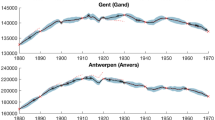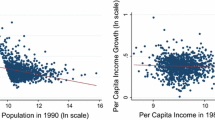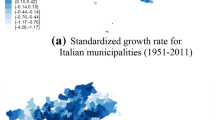Abstract
Modern urban growth literature frequently uses unit-root tests in order to check the empirical relevance of Gibrat’s law of random growth. The contradictory nature of the test results provided by this literature is most likely linked to the low power of unit-root tests. To address this problem, we apply unit-root testing to a large-sized sample of high-quality French census data covering an exceptionally long time span of more than two centuries. We add subsequent cointegration tests in order to detect the possible presence of cointegrated random growth, which may reflect the fact that cities with a similar economic structure react fairly similarly to exogenous growth shocks. According to the test results, the random growth hypothesis cannot be rejected for a very large majority of the tested French cities; on the other hand, the null hypothesis of absence of cointegration cannot be rejected in more than 95% of the cases. Our findings therefore provide empirical support for non-cointegrated random growth.

Similar content being viewed by others
Notes
It should be noted that non rejection of the unit-root hypothesis does not necessarily mean that Gibrat’s law holds.
Double-indexing (i and t) is normally used in a context of panel data analysis. Please note that in the present study, \(S_{i,t}\) is not a panel data variable. The use of index i is justified by the fact that later in this paper, we will have to distinguish between different cities (i and j) in order to discuss cointegration issues.
Complete time-series with 35 census observations are available for 220 of these cities; the time-series of the remaining 30 cities of the dataset are incomplete (with series’ length varying from 19 to 34 census observations).
Complete unit-root and cointegration test results may be requested directly from the authors.
The inverted shape of the lower part of the 2011 rejection-boxplot is explained by the fact that the notch slightly exceeds the first quartile.
This is a minor deviation from the original Engle–Granger approach, because we did not exclude from cointegration testing the 18 cities for which the unit-root hypothesis was rejected in “Unit-root test results”. We did so as not to remove from the outset possible type I errors, which probably represent a sizeable part of the reported unit-root rejections.
References
Black, D., and V. Henderson. 1999. A theory of urban growth. Journal of Political Economy 107: 252–284.
Black, D., and V. Henderson. 2003. Urban evolution in the USA. Journal of Economic Geography 3: 343–372.
Bosker, M., S. Brakman, H. Garretsen, and M. Schramm. 2008. A century of shocks: the evolution of the German city size distribution 1925–1999. Regional Science and Urban Economics 38: 330–347.
Chen, Z., S. Fu, and D. Zhang. 2013. Searching for the parallel growth of cities in China. Urban Studies 50: 2118–2135.
Cheshire, P. 1999. Trends in sizes and structures of urban areas. In Handbook of Regional and Urban Economics, vol. 3, ed. P. Cheshire, and E.S. Mills, 1339–1372. Amsterdam: North-Holland.
Clark, S., and J. Stabler. 1991. Gibrat’s law and the growth of Canadian cities. Urban Studies 28: 635–639.
CNRS, EHESS (2018) Des villages de Cassini aux communes d’aujourd’hui. Database, Centre National de la Recherche Scientifique and Ecole des Hautes Etudes en Sciences Sociales. http://cassini.ehess.fr/cassini/fr/html/index.htm. Accessed 11 Mar 2018
Cochrane, J.H. 1991. A critique of the application of unit root tests. Journal of Economic Dynamics and Control 15: 225–284.
DeJong, D.N., J.C. Nankervis, N.E. Savin, and C.H. Whiteman. 1992. The power problems of unit root tests in time series with autoregressive errors. Journal of Econometrics 53: 323–343.
Dickey, D.A., and W.A. Fuller. 1979. Distribution of the estimators for autoregressive time series with a unit root. Journal of the American Statistical Association 74: 427–431.
Duranton, G., and D. Puga. 2013. The growth of cities. In Handbook of Economic Growth, vol. 2, ed. P. Aghion, and S.N. Durlauf, 781–853. Amsterdam: North-Holland.
Eaton, J., and Z. Eckstein. 1997. Cities and growth: theory and evidence from France and Japan. Regional Science and Urban Economics 27: 443–483.
Eeckhout, J. 2004. Gibrat’s law for (all) cities. American Economic Review 94: 1429–1451.
Engle, R.F., and C.W.J. Granger. 1987. Co-integration and error correction: representation, estimation, and testing. Econometrica 55: 251–276.
Fujita, M., and T. Mori. 1996. The role of ports in the making of major cities: self-agglomeration and hub-effect. Journal of Development Economics 49: 93–120.
Gabaix, X. 1999. Zipf’s law for cities: an explanation. Quarterly Journal of Economics 114: 739–767.
Gibrat, R. 1931. Les Inégalités Économiques, 1st edn. Paris: Sirey
Gonzáles-Val, R., L. Lanaspa, and F. Sanz-Gracia. 2014. New evidence on Gibrat’s law for cities. Urban Studies 51: 93–115.
INSEE (2018) Populations légales, 2011. Database, Institut National de la Statistique et des Etudes Economiques. https://www.insee.fr/fr/statistiques/zones/2123937. Accessed 17 Mar 2018
Karlsson, S., and M. Löthgren. 2000. On the power and interpretation of panel unit root tests. Economics Letters 66: 249–255.
Krugman, P. 1996. The Self-Organizing Economy, 1st ed. Oxford: Blackwell Science.
Lalanne, A., Zumpe, M. 2015. Gibrat’s law, Zipf’s law and cointegration. MPRA Paper 67992, University Library of Munich
MacKinnon, J.G. 1991. Critical values for cointegration tests. Working Paper 1227, Queen’s Economics Department
Perron, P. 1988. Trends and random walks in macroeconomic time series: further evidence from a new approach. Journal of Economic Dynamics and Control 12: 297–332.
Reed, W.J. 2002. On the rank-size distribution for human settlements. Journal of Regional Science 42: 1–17.
Said, E.S., and A.D. Dickey. 1984. Testing for unit roots in autoregressive-moving average models of unknown order. Biometrika 71: 599–607.
Sharma, S. 2003. Persistence and stability in city growth. Journal of Urban Economics 53: 300–320.
Shiller, R.J., and P. Perron. 1985. Testing the random walk hypothesis: power versus frequency of observation. Economics Letters 18: 381–386.
Soo, K.T. 2007. Zipf’s law and urban growth in Malaysia. Urban Studies 44: 1–14.
Author information
Authors and Affiliations
Corresponding author
Additional information
Publisher's Note
Springer Nature remains neutral with regard to jurisdictional claims in published maps and institutional affiliations.
Appendix: Cointegration of \({ln} S_{{i,t}}\) and \({ln} S_{{j,t}}\) Implies Growth Process (5)
Appendix: Cointegration of \({ln} S_{{i,t}}\) and \({ln} S_{{j,t}}\) Implies Growth Process (5)
Assume cointegration of \(ln S_{i,t}\) and \(ln S_{j,t}\), where growth factor shocks \(\gamma _{i,t}\) and \(\gamma _{j,t}\) are iid distributed over time (but not necessarily across cities), with a density distribution \(f (\gamma )\) characterized by \(E[\gamma ] = \mu _{\gamma }\) and \(Var[\gamma ] = \sigma _{\gamma }^{2}\) verifying \(\vert \mu _{\gamma } \vert < \infty\) and \(0< \sigma _{\gamma }^{2} < \infty\). As cointegrated variables must be I(1) , the functional form of \(S_{i,t}\)-growth writes:
In empirical applications, we have necessarily an initial observation \(S_{i,0}\), so we can rewrite equation (A.1) as follows:
In the same way, we obtain for city j:
Cointegration further implies that there is a linear combination of \(ln S_{i,t}\) and \(ln S_{j,t}\) which is I(0) , and as such characterized by time-independence of the first two theoretical moments. So we have to find a way to link (A.2) and (A.3) in a manner that enables us to formulate a linear combination of \(ln S_{i,t}\) and \(ln S_{j,t}\). A general way of doing that is to raise (A.2) and (A.3) to powers \(\delta _{1}\) and \(\delta _{2}\), with \([\delta _{1} \; \delta _{2}]' \ne [0 \; 0]'\), to divide the powered (A.2) by the powered (A.3), and then to take natural logarithms. We get the cointegration equation
where \(\alpha _{ij,0} = \delta _{1} ln S_{i,0} - \delta _{2} ln S_{j,0}\) has a natural interpretation as the difference between the logs of initial population levels of cities i and j, and with \(x_{ij,t} = (\delta _{1} ln \gamma _{i,t} - \delta _{2} ln \gamma _{j,t}) + (\delta _{1} ln \gamma _{i,t-1} - \delta _{2} ln \gamma _{j,t-1}) + \cdots + (\delta _{1} ln \gamma _{i,1} - \delta _{2} ln \gamma _{j,1})\).
Due to time-independence of the first theoretical moments, we have
and
Now define the process \(\lbrace \omega _{ij,t} \rbrace\):
\(\omega _{ij,t}\) is a linear combination of (log transformed) iid processes, so it is itself iid, with mean \(E[\omega _{ij,t} ] = \mu _{\omega }\) and variance \(Var[\omega _{ij,t}] = \sigma _{\omega }^{2}\) verifying \(\vert \mu _{\omega } \vert < \infty\) and \(0< \sigma _{\omega }^{2} < \infty\). We can now rewrite \(x_{ij,t}\) as follows:
implying
and
So we have \(\mu _{x} = t \times \mu _{\omega }\) and \(\sigma _{x}^{2} = t \times \sigma _{\omega }^{2}\) implying \(\mu _{x} = \mu _{\omega } = 0\) and \(\sigma _{x}^{2} = \sigma _{\omega }^{2} = 0 \; \forall t > 0\). Moreover, we necessarily have \(\delta _{1} = \delta _{2}\), because \(E[ln \gamma _{i,t}] = E[ln \gamma _{j,t}]\) and
Finally, with \(E[\omega _{ij,t}] = Var[\omega _{ij,t}] = 0\), we have \(\omega _{ij,t} = 0, \; \forall t\), implying
Growth shocks affecting cities i and j at a given time are thus identical (\(\gamma _{i,t} = \gamma _{j,t} = {\bar{\gamma }}_{t}, \forall t\)), and sizes of i and j are determined by (5).
Rights and permissions
About this article
Cite this article
Lalanne, A., Zumpe, M. Time-Series Based Empirical Assessment of Random Urban Growth: New Evidence from France. J. Quant. Econ. 18, 911–926 (2020). https://doi.org/10.1007/s40953-020-00204-0
Published:
Issue Date:
DOI: https://doi.org/10.1007/s40953-020-00204-0




